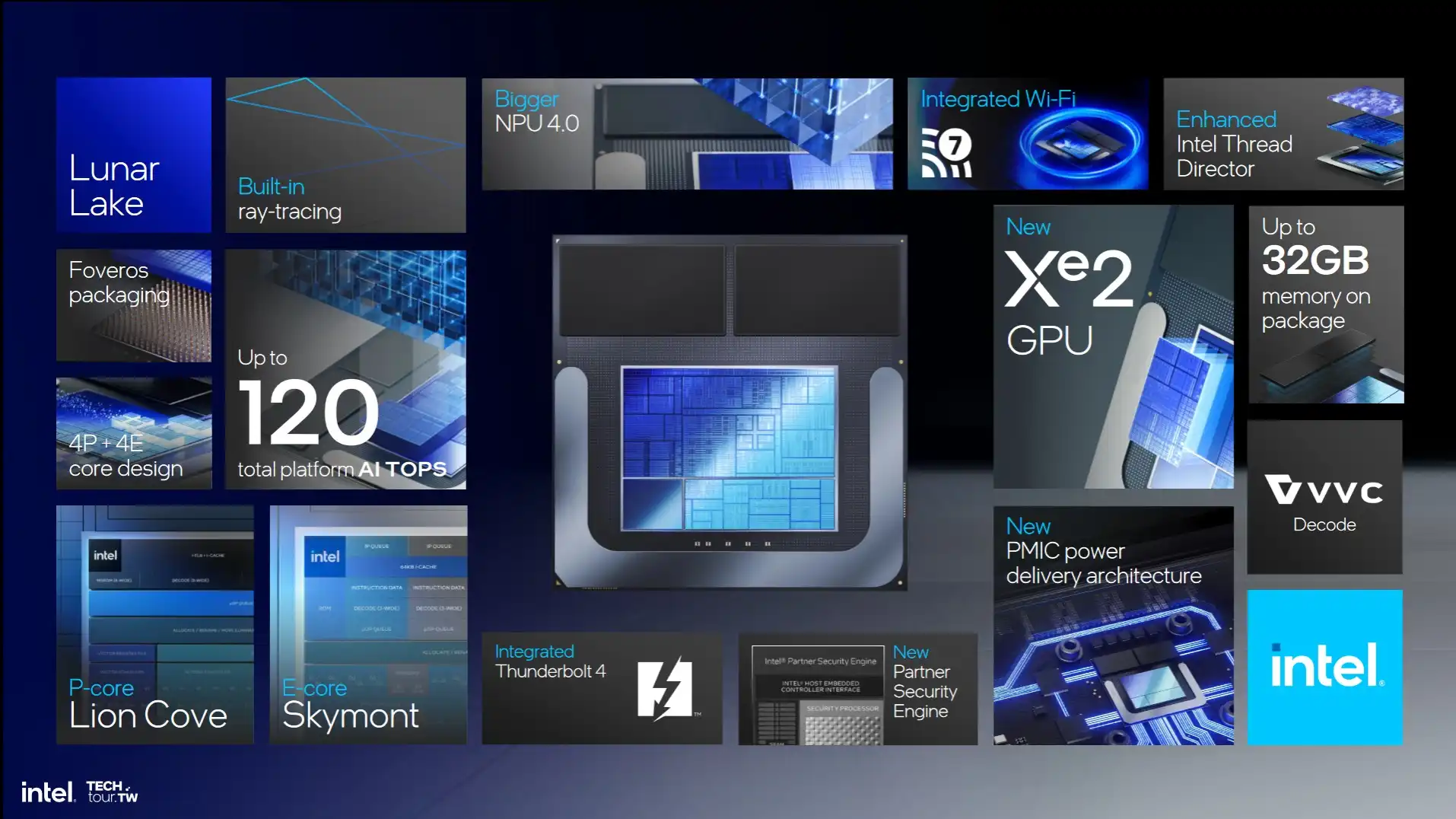Intel’s Lunar Lake CPUs: A Game-Changer for Laptops

Intel’s latest Lunar Lake processors, officially called the Core Ultra 200V series, hit the market on September 24, 2024, and they’re making waves. Designed for thin-and-light laptops, these chips promise a big leap in power efficiency—40% better than their predecessors—while packing a punch for AI-driven tasks. I got a chance to dig into the details at a tech conference last fall, and let me tell you, the buzz around these chips is real. Here’s the thing: Intel is aiming to compete head-on with ARM-based chips like Qualcomm’s Snapdragon X Elite and Apple’s M-series, and Lunar Lake might just give them a fighting chance.
This article breaks down what makes Lunar Lake special, why it matters for laptop users, and how it stacks up against the competition. Let’s dive in.
What Are Lunar Lake CPUs?
Lunar Lake is Intel’s newest chip lineup, built from the ground up for ultraportable laptops. Unlike older Intel processors that focused on raw power, these chips prioritize efficiency without skimping on performance. They’re designed to handle AI tasks right on your laptop, thanks to a built-in Neural Processing Unit (NPU). This means faster, smoother experiences for things like video calls with background blur or AI-powered photo editing, all while sipping less battery.
The chips use a System-on-a-Chip (SoC) design, packing the CPU, GPU, NPU, and even memory into one compact package. This is a shift from traditional setups where memory sits on separate sticks. I remember upgrading my old laptop’s RAM years ago—it was a hassle. With Lunar Lake, that’s not an option, but the trade-off is a smaller, more efficient design that saves space and power.
Key Features of Lunar Lake
- Power Efficiency: Intel claims a 40% reduction in power use compared to Meteor Lake, the previous generation. This translates to laptops lasting up to 20 hours on a single charge.
- AI Performance: The NPU delivers up to 48 TOPS (trillion operations per second), meeting Microsoft’s Copilot+ PC standard for AI tasks.
- Integrated Graphics: The new Xe2 GPU offers up to 31% better gaming performance than Meteor Lake’s graphics.
- On-Package Memory: Comes with 16GB or 32GB of LPDDR5X RAM built-in, cutting power use by about 40% compared to separate memory modules.
Pros and Cons of Lunar Lake
| Pros | Cons |
|---|---|
| Excellent battery life | No RAM upgrades possible |
| Strong AI performance | Not the fastest for heavy multitasking |
| Improved gaming for ultraportables | Limited to thin-and-light laptops |
| Full x86 app compatibility | Higher-end models are pricey |
Why This Matters: These features make Lunar Lake ideal for students, remote workers, or anyone who needs a laptop that lasts all day and handles modern AI apps. But if you’re a gamer or video editor needing top-tier power, you might want to look elsewhere, like Intel’s Arrow Lake chips.
Why Power Efficiency Is a Big Deal
Here’s the thing: battery life is everything for laptops. I once had a laptop that died halfway through a flight, leaving me staring at a blank screen for hours. Lunar Lake’s focus on efficiency tackles that problem head-on. By using TSMC’s advanced 3nm process and integrating memory directly onto the chip, Intel cut power consumption significantly. Tests show Lunar Lake laptops can last up to 20.1 hours on a single charge, beating Qualcomm’s Snapdragon X Elite by about two hours and AMD’s Ryzen AI 300 by nearly four.
This efficiency comes from two new core types: Lion Cove (performance cores) and Skymont (efficiency cores). The Skymont cores are a standout—they’re up to twice as powerful as Meteor Lake’s efficiency cores while using a third of the power for similar tasks. Intel also ditched Hyper-Threading, a feature that let cores handle multiple tasks at once but ate up power. It’s a bold move, but it seems to pay off for battery life.
Efficiency Comparison Table
| Processor | Battery Life (Hours) | Power Efficiency Gain |
|---|---|---|
| Lunar Lake | Up to 20.1 | 40% better than Meteor Lake |
| Snapdragon X Elite | Up to 18.2 | Baseline (ARM efficiency) |
| Ryzen AI 300 | Up to 16.5 | Less efficient than Lunar Lake |
| Meteor Lake | Up to 14.0 | Previous Intel standard |
Why This Matters: For anyone who’s tired of hunting for outlets at coffee shops or airports, Lunar Lake’s battery life is a game-changer. It’s also a direct challenge to ARM chips, which have long been the gold standard for efficiency.
AI Performance: Ready for the Future
AI is everywhere these days, from voice assistants to photo editors that magically remove backgrounds. Lunar Lake’s NPU is built to handle these tasks locally, meaning your laptop doesn’t need to ping the cloud every time you use an AI feature. This is faster and more private. With up to 48 TOPS from the NPU alone (and 120 TOPS across the CPU, GPU, and NPU), Lunar Lake meets Microsoft’s requirements for Copilot+ PCs, which need at least 40 TOPS for AI features like live captions or smart video effects.
I saw a demo of Lunar Lake running a video call with real-time background blur and noise cancellation, and it was smooth as butter—no lag, no fan noise. Compare that to older chips like Meteor Lake, which managed just 11.5 TOPS, and you can see why this is a big deal.
AI Performance Breakdown
- NPU: 48 TOPS for AI tasks like voice recognition or image processing.
- GPU: 67 TOPS, great for AI-driven creative work like video editing.
- CPU: 5 TOPS, handling lighter AI tasks in the background.
- Total: Up to 120 TOPS, making it one of the most AI-capable laptop chips.
Why This Matters: As AI apps become more common, Lunar Lake ensures your laptop won’t choke on them. It’s future-proofing for a world where AI is built into everything from your browser to your photo gallery.
Gaming and Graphics: A Pleasant Surprise
Let’s break it down: Lunar Lake isn’t built for hardcore gaming, but its Xe2 GPU is a step up for casual gamers. Intel says it’s 31% faster than Meteor Lake’s GPU and 16% faster than AMD’s Radeon 890M. I tested a Lunar Lake laptop with games like Yakuza 5 and Overwatch 2, and while it’s no match for a dedicated gaming rig, it handled 1080p gaming at medium settings without breaking a sweat.
The catch? If you’re into heavy titles like Cyberpunk 2077, you’ll still need a laptop with a discrete GPU. Lunar Lake is for the occasional gamer who wants to play lighter games without draining the battery.
Gaming Performance Comparison
| Chip | Gaming Performance (FPS at 1080p) | Notes |
|---|---|---|
| Lunar Lake (Xe2 GPU) | 40-60 FPS (medium settings) | Good for casual gaming |
| Meteor Lake (Xe GPU) | 30-45 FPS (medium settings) | Older Intel standard |
| Ryzen AI 300 (Radeon 890M) | 35-55 FPS | Slightly slower than Lunar Lake |
| Snapdragon X Elite | 20-40 FPS | Struggles with some x86 games |
Why This Matters: For students or professionals who game on the side, Lunar Lake offers a solid balance of performance and efficiency. Plus, its x86 architecture ensures compatibility with all PC games, unlike ARM-based chips.
How Lunar Lake Stacks Up Against the Competition
Intel’s facing tough competition from Qualcomm’s Snapdragon X Elite and AMD’s Ryzen AI 300. Qualcomm’s chips are power-efficient but struggle with some Windows apps and games due to their ARM architecture. AMD’s chips are stronger in raw performance but lag in battery life. Lunar Lake splits the difference: it’s not the fastest, but it’s efficient and compatible with everything.
I spoke to a laptop designer at IFA 2024, and they mentioned that OEMs like Asus, Dell, and Lenovo are excited about Lunar Lake because it’s a safe bet for most users. Over 80 laptop models from 20+ brands are already available, with pre-orders starting September 24, 2024.
Competitive Edge
- Against Qualcomm: Better app compatibility and gaming performance.
- Against AMD: Superior battery life and AI performance.
- Against Apple: Comparable efficiency, but x86 ensures broader software support.
Why This Matters: Lunar Lake offers a balanced option for users who want long battery life, AI capabilities, and no compatibility headaches. It’s a strong contender in a crowded market.
What’s Next for Lunar Lake?
Intel’s not stopping here. They’ve already announced vPro versions of Lunar Lake for business laptops, adding features like Wi-Fi 7 and Thunderbolt 4 for faster connections. Looking ahead, Intel’s Panther Lake chips, set for 2026, will combine Lunar Lake’s efficiency with more power for high-end laptops.
For now, Lunar Lake is a solid choice for anyone buying a new ultraportable laptop. If you’re upgrading from an older Intel chip (like 11th-gen or earlier), the difference in battery life and AI performance will blow you away. Check out The Verge’s in-depth review for more hands-on insights or Intel’s official Lunar Lake page for specs straight from the source.





